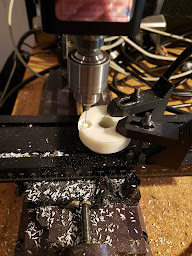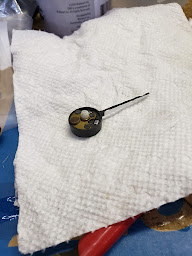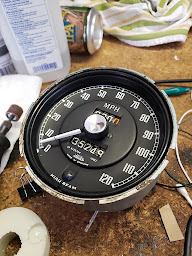The MGB Tachometer and Speedometer Have Guided Me Since I was 16!
And I am determined that they will again...one day!
That's actually pretty easy code. I fortunately had a tiny drill bit left over from my fountain pen/stylus days which made a perfect press fit over the wire.
It pressed into the needle OK.
As I observed when I repainted the dash, one spends a lot of time looking at one's dash and seeing the flailing gauges was disturbing. The Tachometer bounced around wildly, generally reading well above the actual speed. The speedometer was connected to the wrong transmissions, since the previous owner had upgraded to the synchronized 1st gear version. Therefore, it always read about 25% too high of speed and also bounced around a lot.
I quickly learned that my car repair background was of no use here as these are basically watches! Very tiny parts with delicate springs and needles! And I broke and subsequently repaired several of the parts!
cable from the transmission output shaft turns a shaft with magnets on it over an Aluminum disc. This creates eddy currents in the Aluminum and eddy currents create torque on the disc. The disc has the needle on it and reacts against a torsion spring. Since eddy currents are directly proportional to the speed of the magnetic field, it moves in proportion to the speed. Since the forces are small, the whole thing relies on very low friction. On the back of the speedometer they admit that there are no jewels. I always wondered what that meant so I checked Wikipedia: https://en.wikipedia.org/wiki/Jewel_bearing . Very nifty. I have no idea how people made something so small in the early 1900's but more power to them. In any case, BB has no jewels. Just plain brass bearings. So friction reduction will be a priority.




As you can see above, the front cover comes off with a twist. The green disc is a friction increasing device for removing jar tops. Very handy here! I ended up buying new O-rings for under the glass from Moss. I may have misused them (perhaps they go between dash and gauge?), but they were a tad big so I cut out a slice until the diameter fit. They were still a bit thick, so I used needle nose pliers to bend a small angle on the slots where the cover ring fits on. That part went fine.




Even easier was the cleaning. I somehow got the idea to use a Mr. Clean Magic Eraser. This is basically a foam sponge with a very mild abrasive in it. This cleaned up the chrome ring and the instrument face very easily and they look like new!
 Then began my trouble. I was somehow convinced that the needle was off center. So I decided to gently bend it. That seemed to work so I tried it three more times and then broke the needle off! As you can see above. This caused a stone to sink to the bottom of my stomach! These speedometers are made of unobtanium! Moss and Victoria British don't sell them anymore. Where would I get one! I first tried epoxy but it broke right off. I thought for several days, made measurements, had dreams, and started a scheme! What if I could make a bushing to reattach it?
Then began my trouble. I was somehow convinced that the needle was off center. So I decided to gently bend it. That seemed to work so I tried it three more times and then broke the needle off! As you can see above. This caused a stone to sink to the bottom of my stomach! These speedometers are made of unobtanium! Moss and Victoria British don't sell them anymore. Where would I get one! I first tried epoxy but it broke right off. I thought for several days, made measurements, had dreams, and started a scheme! What if I could make a bushing to reattach it?
Fortunately, I have a small CNC milling machine and some extra nylon material for a project which I can't remember. So, I started my new career as a watch maker and milled a bushing that would press into the needle and over the remains of the wire on the Aluminum disc!
That's actually pretty easy code. I fortunately had a tiny drill bit left over from my fountain pen/stylus days which made a perfect press fit over the wire.
It pressed into the needle OK.
And onto the wire OK! And it has only fallen off once when the drone motor I later decided to install, went over speed and knocked it loose. That's a blog post for another day! At this point, I was very happy with the progress and reinstalled the instrument.
Now, onto the tachometer, which is an equally ingenious device (although it also has no jewels!). I had the exact same issues with glass and O-ring. You can see the electronics on the inside. This was produced in 1967 and featured two transistors! The transistor was invented at Bell Labs just 20 years before. Twenty years seems like a long time but most major innovations take 30 years to reach a stable market. Television is a good example. The transistor, however, is subject to Moore's law, which says that costs halve and density doubles every two years. Insanely, this curve is not interrupted by war or depression and Ray Kurzweil has even shown that it goes back the abaqus if you calculate computations/$/sec. The phone in your pocket has Billions (yes, that's a capital "B"!) of them in it! Progress marches on!




However, my main problem here was friction. I tried multiple lubricants including 3M dry Silicon, WD-40, and motor oil. Nothing did the trick except PB Blaster! A Cleveland produced penetrating oil which after two small drops, freed up the mechanism and it has been steady ever since! I will caution you: If you are tempted to use carburetor cleaner to clean out the joints, Don't Do It! I tried and nearly wiped all the numbers off the face! The stuff eats paint like it's hot dogs in a contest!


You can see that Mr. Clean had more work to do here but it looks amazing now!


Those pictures were taken before I accidentally bent the needle and straightened it! The needle is actually foil and bends very easily. Don't touch! I managed to straighten it and no one who has not read this blog post would see it! I see it every day and it reminds me not to become a watch repairman!
And, both gauges now give meaningful readings and don't bounce (much) and it makes me very happy. Furthermore, it enables me to have #funwithcars!
Keep driving and keep an eye on your instruments!







Comments
Post a Comment